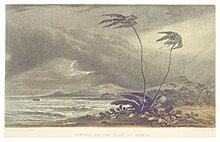History of Kedah

| History of Malaysia |
|---|
 |
|
|
By around 788
Early west-coast trade centres are few in number as they were overshadowed by Kedah. Her nearness to the entrances to the
After the 7th century, Srivijaya subjugated Kedah, but due to her fame, Indian sources continue to depict Kedah. Early Kedah also supplied its own tin, and jungle products such as rattan, resin, honey, beeswax, elephants, ivory, areca nuts, sepang wood and black woods, as well as profiting from tax collections.
The early history of Kedah can be traced from various sources, from the prehistoric period to the archaeological site of Bujang Valley, the early maritime trade of India, Persia, and the Arabs to the written works of early Chinese pilgrims and early Chinese records, the Hikayat Merong Mahawangsa (known as Kedah Annals) to Al-Tarikh Salasilah Negeri Kedah.
Origins
Ancient history

Austronesians were great seafarers, colonising as far as New Zealand, Hawaii and Madagascar. In some regions they intermarried with the local inhabitants (Orang Asli), becoming the Deutero-Malays. Possibly as early as the 4th century BCE, Austronesians started to sail westwards in search of new markets for their products.[4][5]
Some
Three kinds of craft are described by the author of the Periplus: light coasting boats for local traffic, larger vessels of a more complicated structure and greater carrying capacity, and lastly the big ocean-going vessels that made the voyages to Malaya, Sumatra, and the Ganges.[7]

Pre-Hindu civilisation
Deep in the pristine estuary of the
The historical landscape of the area was bound to a flourishing iron industry, with archaeological findings unearthed various historical mines, warehouses, factories, a harbour; together with a vibrant plethora of superior-quality
The settlement also narrated a glimpse of the ancient religious undertakings prior to the mass
In addition to Sungai Batu, the early Malay archipelago also witnessed the monumental development of other subsequent ancient large urban settlements and regional polities, driven by a predominantly cosmopolitan agrarian society, thriving skilled craftsmanship, multinational merchants and foreign expatriates. Chinese records noted the names of Akola,
Medieval history

Early in the
In
An inscribed stone bar, rectangular in shape, bears the
Inscriptions, both in
In Kedah, an inscription in Sanskrit dated 1086 CE has been found. This was left by
An indigenous style develops

The
as well.There are stone inscriptions which indicate that the Kedah region at 400 CE or before was already an established trade centre. One of the early Malay texts include the karma verses refers to a king named Ramaunibham, who may be the first local ruler whose name is recorded in history. The history of this period showed the influence of Indian cultures on the region while the locals in return, influenced the Indians in their living skills on the sea and in the hills.
See also
- Red Earth Kingdom / Chi Tu
- Sultanate of Kedah
- Trade route
- Cities along the Silk Road
- Kingdom of Setul Mambang Segara
Notes
- ^ Vinodh Rajan (2 April 2012). "Ye Dhamma – The Verse of Causation". Vinodh's Virtual Cyber Space. Archived from the original on 20 March 2012. Retrieved 13 April 2012.
The Pali verse 'Ye Dhamma... ' is a popular verse in Buddhism that explains the heart of Buddhism Philosophy i.e Dependent Origination. The Sanskrit version of the verse is called "Pratityasamutpada Hridaya Dharani" [The Heart Dharani of Dependent Origination] with Om added to the beginning of the Verse, and Svaha added at the end, thus Dharani-fying the entire verse. The Pali version never seems to have had any specific title.
References
- ^ "Sg Batu to be developed into archaeological hub". The Star. 3 October 2020. Retrieved 8 November 2020.
- ^ "FIVE REASONS WHY YOU MUST VISIT THE SUNGAI BATU ARCHAEOLOGICAL SITE AT LEAST ONCE IN YOUR LIFETIME". Universiti Sains Malaysia. 14 November 2019. Archived from the original on 17 June 2021. Retrieved 8 November 2020.
- )
- ISBN 9781920942854. Archivedfrom the original on 2 April 2020. Retrieved 23 March 2019.
- ISBN 9789971696429. Archived(PDF) from the original on 30 December 2019. Retrieved 23 March 2019.
- ^ Dick-Read, Robert (2005). The Phantom Voyagers: Evidence of Indonesian Settlement in Africa in Ancient Times. Thurlton.
- ^ Sastri, K.A. Nilakanta (2000) [1935]. Cholas (fifth printing ed.). Chennai: University of Madras. pp. 86 & 318.
- ^ Mok 2017.
- ^ a b c d Pearson 2015
- ^ a b c d Hall 2017
- ^ Sastri, K.A. Nilakanta (1949). South Indian Influences in the Far East. Bombay: Hind Kitabs Ltd. pp. 82& 84.
- ^ Sastri, K.A. Nilakanta (1949). South Indian Influences in the Far East. Bombay: Hind Kitab Ltd. pp. 28& 48.
- ^ a b Arokiaswamy, Celine W.M. (2000). Tamil Influences in Malaysia, Indonesia, and the Philippines. Manila s.n. p. 41.
{{cite book}}: CS1 maint: location missing publisher (link)
Sources
- Hall, Thomas D. (2017), Comparing Globalizations Historical and World-Systems Approaches, Springer, ISBN 9783319682198
- Mok, Opalyn (9 June 2017). "Archaeologists search for a king in Sungai Batu". The Malay Mail.
- Pearson, Michael (2015), Trade, Circulation, and Flow in the Indian Ocean World, Palgrave Series in Indian Ocean World Studies, Palgrave Macmillan, ISBN 9781137566249
Further reading
- The Encyclopedia of Malaysia: Early History, Volume 4 / edited by Nik Hassan Shuhaimi Nik Abdul Rahman (ISBN 981-3018-42-9)
